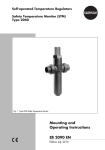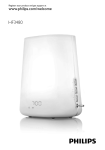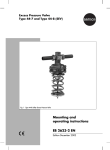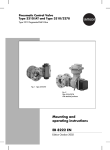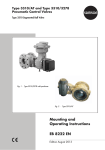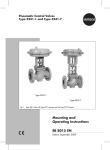Download Mounting and Operating Instructions EB 8340 EN
Transcript
Electrohydraulic Actuators Type 3274 Fig. 1 · Type 3274 Electrohydraulic Actuator Mounting and Operating Instructions EB 8340 EN Edition March 2012 Contents Contents 1 1.1 Design and principle of operation. . . . . . . . . . . . . . . . . . . . 5 Versions . . . . . . . . . . . . . . . . . . . . . . . . . . . . . . . . 5 1.2 Principle of operation . . . . . . . . . . . . . . . . . . . . . . . . . . 6 1.3 Additional electric equipment . . . . . . . . . . . . . . . . . . . . . . 6 2 2.1 Installation . . . . . . . . . . . . . . . . . . . . . . . . . . . . . . . 8 Assembling the actuator and valve. . . . . . . . . . . . . . . . . . . . 8 3 Electrical connections . . . . . . . . . . . . . . . . . . . . . . . . . 10 4 4.1 Operation. . . . . . . . . . . . . . . . . . . . . . . . . . . . . . . 13 Override of the actuator . . . . . . . . . . . . . . . . . . . . . . . . 13 4.1.1 4.1.2 4.2 Version with electric override. . . . . . . . . . . . . . . . . . . . . . 13 Version with mechanical override . . . . . . . . . . . . . . . . . . . 15 Adjusting additional electric equipment. . . . . . . . . . . . . . . . . 15 4.2.1 4.2.2 4.2.3 4.2.4 Positioner . . . . . Position transmitter Potentiometer . . . Limit contacts . . . 5 Dimensions in mm. . . . . . . . . . . . . . . . . . . . . . . . . . . 21 2 EB 8340 EN . . . . . . . . . . . . . . . . . . . . . . . . . . . . . . . . . . . . . . . . . . . . . . . . . . . . . . . . . . . . . . . . . . . . . . . . . . . . . . . . . . . . . . . . . . . . . . . . . . . . . . . . 15 18 19 19 Safety instructions General safety instructions For your own safety, follow these instructions concerning the mounting, start up and operation of the actuator: 4 The actuator may only be mounted, started up or operated by trained and experienced personnel familiar with the product. According to these Mounting and Operating Instructions, trained personnel refers to individuals who are able to judge the work they are assigned to and recognize possible dangers due to their specialized training, their knowledge and experience as well as their knowledge of the relevant standards. 4 Any hazards that could be caused by the process medium, operating pressu- re or by moving parts are to be prevented by means of the appropriate measures. 4 The actuator has been designed for use in low voltage installations. 4 During wiring and maintenance, you are required to observe the relevant safety regulations. Take necessary measures to ensure that the power supply cannot be reconnected inadvertently. 4 Before connection, disconnect the power to the actuator. To avoid damage to any equipment, the following also applies: 4 Proper shipping and appropriate storage are assumed. EB 8340 EN 3 Technical data Actuator Type 3274 -11 -12 Version with override -13 -14 -15 Electric -16 -17 -18 -21 Mechanical -22 Fail-safe action With Without Operating direction Rated travel Extends Retracts Extends 15 or 30 mm Rated actuating time 60 s with 15 mm · 120 s with 30 mm depending on temperature and required actuating force Actuating time for fail-safe action [mm/s] Actuating force (N) with -23 Electric normal – optional Stem retracts 2100 500 4300 500 2100 500 4300 500 1 1 3.3 3.3 1.3 5 2100 1800 500 15 mm travel: Stem extends 2000 3400 4300 7700 2000 3400 4300 7700 2000 2300 3400 30 mm travel: Stem extends 1800 3000 4300 7300 1800 3000 4300 7300 1800 2100 3000 Stem retracts 2100 500 4300 500 2100 500 4300 500 2100 1800 500 230 V, 110 V, 24 V, 50 or 60 Hz (both ±10 %) Power supply Power consumption with power supply 24 V, 110 V, 230 V/50 Hz 24 V, 110 V, 230 V/60 Hz 110 V, 230 V/50 Hz with faster motor 110 V, 230 V/60 Hz with faster motor Positioner Permissible ambient temperature 90 VA 110 VA 150 VA 185 VA 3 VA –10 to +60 °C · With heating resistor: –35 to +60 °C Storage temperature –25 to +70 °C Electromagnetic compatibility Complying with EN 61326-1, EN 61000-6-2 and EN 61000-6-3 Degree of protection IP 65 according to EN 60529 Weight Approx. kg 12 15 12 Additional electrical equipment Positioner Power supply 230 V, 110 V, 24 V; 50 or 60 Hz (both ±10 %) Control signal 4(0) to 20 mA (Ri = 50 W) · 0(2) to 10 V (Ri = 10 kW) Zero shift 0 to 100 % Change of span 30 to 100 % 0(4) to 20 mA, RB £ 200 W · 0(2) to 10 V, RB £ 2 kW Output (feedback) Hysteresis Approx. 3 % 0 to 1000 W, 0 to 200 W, 0 to 100 W, 0 to 275 W, 0 to 138 W (when rated travel is 80 % of final value), permissible load 0.5 W Potentiometers Electric limit contacts Maximum three separately adjustable limit contacts, 250 V AC, 5 A Inductive limit contacts Proximity switch SJ 2-N (NC contacts only) Control circuit Heating resistor, approx. 45 W Values according to downstream isolating amplifier With thermostat, activated at –10 °C, deactivated at approx. 0 °C Materials Housing, cover Die-cast aluminum 4 EB 8340 EN Cylinder Piston Piston rod Actuator stem Hydraulic oil Hydraulic cylinder tube Steel/NBR combination C 45, hard chrome plating 1.4104 Special HPL, silicone-free Design and principle of operation 1 Design and operation principle of The electrohydraulic actuators are especially suitable for attachment to SAMSON Series 240, 250 and 280 Valves. The actuators are connected to the valve bonnet by a ring nut. The actuator and plug stem are tightly connected by a stem connector. The actuator essentially consists of the actuator housing, the motor including oil pump as well as the cylinder housing with piston. Pilot valves control the supply and discharge of the compressed oil at the piston. The actuator is equipped with compression springs which determine the positioning forces. Actuator versions with spring mechanism also serve to move valve to the fail-safe position “Actuator stem retracts“ or “Actuator stem extends“ in the event of a power supply failure. 1.1 Versions The following versions are available for different applications: Versions with electric override Type 3274-11 · Electrohydraulic actuator with an actuating force Fretracts of 2100 N in direction of action “Actuator stem retracts” and an actuating force Fextends of 1800 N in direction of action “Actuator stem extends” Type 3274-12 · Electrohydraulic actuator with actuating forces Fretracts of 500 N and Fextends of 3000 N Type 3274-13 · Electrohydraulic actuator with actuating forces Fretracts and Fextends of 4300 N Type 3274-14 · Electrohydraulic actuator with actuating forces Fretracts of 500 N and Fretracts of 7300 N. Versions with mechanical override These versions have a mechanical override instead of an electric override. Type 3274-15 · Electrohydraulic actuator with same actuating forces as Type 3274-11 Type 3274-16 · Electrohydraulic actuator with same actuating forces as Type 3274-12 Type 3274-17 · Electrohydraulic actuator with same actuating forces as Type 3274-13 Type 3274-18 · Electrohydraulic actuator with same actuating forces as Type 3274-14 Versions with fail-safe action and electric override Type 3274-21 · Electrohydraulic actuator with actuating force Fretracts of 2100 N and Fextends of 1800 N. Fail-safe action: “Actuator stem extends” Type 3274-22 · Electrohydraulic actuator with actuating force Fretracts of 1800 N and Fextends of 2100 N. Fail-safe action: “Actuator stem retracts” Type 3274-23 · Electrohydraulic actuator with actuating force Fretracts of 500 N and Fextends of 3000 N. Fail-safe action: “Actuator stem extends” Typetesting The Type 3274-21 and Type 3247-23 Actuators are typetested with various SAMSON valves by TÜV according to DIN EN 14597. See the nameplate for the DIN register number. EB 8340 EN 5 Design and principle of operation 1.2 Principle of operation The pressure-tight actuator housing (1) (Fig. 2) also serves as the oil reservoir and incorporates the cylinder housing (2), cylinder (5.1) and piston (5.2), motor (6.1), pump (6.2) and solenoid pilot valves (6.4). The oil pump (6.2) driven by the motor (6.1) feeds compressed oil to the corresponding cylinder chamber over the check valve (6.3) and pilot valve (6.4). The solenoid valves are closed in the de-energized state. They open when the controller issues an output signal. When reaching a final position or when the actuating force is exceeded due to external forces, the motor is switched off. Depending on the version, the actuators are equipped without compression springs or with one or two compression springs (5.7, 5.8). The motor of Types 3274-11, -12, -15, -16 and -21 to -23 only determine the valve position in one direction, while the springs are used to return the valve to its fail-safe position. Actuators with electric override have two pushbuttons to extend or retract the actuator stem. Actuators with mechanical override have an extra gear housing. An Allen key must be inserted to activate the override function. In combination with a release button on the top of the actuator housing, the actuator stem can be extended or retracted. Versions with fail-safe action have a spring return mechanism and an additional safety solenoid valve which opens when the power supply is interrupted, reducing the pressure on the cylinder chamber. The spring return 6 EB 8340 EN mechanism moves the valve to the fail-safe position. 1.3 Additional electric equipment All additional electric equipment are located in the terminal box (3). A rack-and-pinion gear converts the linear travel of the actuator stem into a rotary motion which is picked off at the shaft to operate the switching and signaling elements. Additional electric equipment can be retrofitted. The maximum equipment configuration is shown in the table in section 4.2. Electric positioner The positioner compares the 4(0) to 20 mA or 0(2) to 10 V signal issued by a controller to the signal issued by a potentiometer. The potentiometer signal is proportional to the travel. The output variable produced by the positioner is a three-point stepping control signal. Position transmitter In the version with three-point stepping signal, an 0(4) to 20 mA or 0(2) to 10 V output signal is generated proportional to the travel of the valve using a 0 to 1000 W potentiometer. Potentiometer The actuators can be equipped with two potentiometers. A gear segment is driven by a shaft. An easily adjustable transmission mechanism including a twin pinion ensures that the angle of rotation remains the same for rated travels of 15 and 30 mm. Electric limit contacts The actuators can be equipped with a maximum of three overrideable electric switches Design and principle of operation on request. They are actuated by infinitely adjustable cams. The motor is switched off with force-dependent, fixed switches located in the actuator housing (1). Actuators with spring return mechanism only contain one force-dependent switch since the springs (5.7 and 5.8) determine the other end position. with two resistors by the manufacturer. The heating is activated by thermostats when the oil temperature falls below –10 °C and deactivated when the oil reaches a temperature of 0 °C. The electrical connection is established at N and L. The heating is not protected by an internal fuse. Priority circuit The positioner version is equipped with a priority circuit at terminals 82 and 83 (see section 4.2.1). Heating For lower ambient temperature ranges, the oil reservoir can be equipped with a heating 1 6.4 3 6.3 6.2 5.2 6.1 5.1 2 5.7 5.8 NOTICE The housing cover is secured by leaded screws. All parts in the actuator housing are maintenance-free and must not be tampered with. Do not open the housing! 5.4 5.6 1 1.1 2 3 3.1 4.3 4.4 5.1 5.2 5.10 5.11 6.1 6.2 6.3 6.4 Actuator housing and oil reservoir Housing cover Cylinder housing Terminal box Cover Limit contact (extending) Limit contact (retracting) Cylinder Piston Compression spring Compression spring Motor Oil pump Check valve Pilot valve Fig. 2 · Functional diagram EB 8340 EN 7 Installation 2 2.1 Installation Mounting position: To meet the mounting requirements of actuators with heating and/or manual override, the following mounting positions should be observed. Assembling the actuator and valve If the actuator has not been mounted on the valve prior to delivery, proceed as follows (see Fig. 4): Not permissible Permissible Permissible Not permissible Check whether the actuator stem is retracted. For versions with electric override: 4 Connect actuator to power supply (see section 3). 4 Disconnect isolating terminal 81 (see section 4.1) and use pushbutton IN to retract the actuator stem. Fig. 3 · Mounting positions The installation of the actuator also depends on the mounting position of the control valve used (see the associated mounting and operating instructions). For valve sizes DN 100 or above, install the actuator upright to facilitate any maintenance required. Always observe minimum clearance for removal of the cover or the complete actuator (see dimensional drawings, section 5). For versions with mechanical override: 4 Press button on the top of the actuator housing. 4 Use an Allen key to operate the rack-and-pinion gear and slowly retract the actuator stem. For versions with fail-safe action "Actuator stem extends", keep the power supply to the actuator connected, otherwise the fail-safe function will extend the actuator stem again. DN 15 to 80 (Series 240) 1. Replace stem connector nut (9.3, Fig. 4) with an external Ø 10 mm on the plug stem with a Ø 16 mm nut (order no. 0250-0674). 2. After replacing the stem connector nut (9.3), adjust dimension x to 75 mm with a closed valve and tighten lock nut (9.4). 3. Place the actuator on the valve bonnet, fasten tight using the ring nut (8.1). 4. Push plug stem (9.5) upward. Connect stem connector nut (9.3) and actuator 8 EB 8340 EN Installation stem using the stem connector clamps (8.2). 5. Move the valve to its end position and align travel indicator scale (9.2) with the tip of the stem connector. DN 100 to 150 (Series 240 as well as Series 250 and 280, KVS 40 to 160) 1. Check that dimension x = 90 mm, readjust, if necessary, by turning the stem connector nut (9.3). 2. Place the actuator on the valve bonnet and fasten tightly using the ring nut (8.1). 3. Connect stem connector nut (9.3) and actuator stem (5.6) using the stem connector clamps (8.2), fasten together tightly. 4. Move the valve to its end position, align travel indicator scale (9.2) with tip of the stem connector (8.2) and screw tight. 8 8.1 5.6 8.2 9.3 9.4 x 9.2 9.1 8 8.1 5.6 8.2 9.1 9.2 9.3 9.4 9.5 Actuator Ring nut Actuator stem Stem connector Valve bonnet Travel indicator scale Stem connector nut Lock nut Plug stem 9.5 Fig. 4 · Attachment to the actuator EB 8340 EN 9 Electrical connections 3 Electrical connections Risk of electric shock! When installing electric lines, you are required to observe the regulations governing electrical power plant installation according to DIN VDE 0100 as well as the regulations of your local power supply company. CAUTION! Use a suitable power supply which guarantees that no dangerous voltages reach the device in normal operation or in case of a fault in the system or any other system parts. Connect the actuator to the electrical network only after the power supply is first switched off. Make sure the power cannot be switched on unintentionally! Particularly for 24 V, 50 Hz actuators, use wires with a sufficiently large cross section in order to guarantee that the permissible voltage tolerances of ±10 % are not exceeded. Note: When electrical connections are made as described in the circuit diagrams, special electronics in the motor ensure that the contacts of controller's output relays (e.g. with controllers for three-point stepping signal) are protected and only a relatively low power load is used. A triac and a relay in the motor electronics connect the power. 10 EB 8340 EN 4 Unfasten the side housing cover. Guide the wires through the cable glands on the housing to the terminals and connect them (see Figs. 5 to 7 or the circuit diagram inside the housing cover). Knock out the sealing plugs next to the existing cable entries, if required, to use two additional cable entries. 4 Connect safety conductor to the separate safety conductor terminal on the inside housing wall. Electrical additional equipment Circuit diagrams 5 to 7 also apply to the additional equipment. Note that the limit contacts must not be connected to the terminal strip but to separate screw terminals. In the version with positioner (Fig. 6) and position transmitter (Fig. 7), output signals which are proportional to the valve travel can be provided at the terminals 31, 32, 33 to be used for control and signaling purposes (signal increases when the actuator stem retracts). NOTICE When a device is connected at the voltage output, terminals 31 and 32 must be jumpered. Fuses The board with the electronics section of the motor contains a clamp with a 5 x 20 mm glass-tube fuse which is used to protect the actuator and the contacts of the external controller when the actuator is wired as shown in Figs. 5 to 7. Electrical connections Supply voltage 230 V, 50/60 Hz T1L 250 (1 A slow fuse) 2 F e Retracts F a ϑ N L aL 3274-11...-18,-21,-23 M 3274-13,-14,-17,-18,-22 Heating resistor Actuators with a transit time of 60 s for 30 mm travel: 230 V, 50 Hz T1.25, 250 (1.25 slow fuse) 110 V, 50 Hz T1.25 (1.25 A slow fuse) 24 V, 50 Hz T6.3 (6.3 A slow fuse) eL a43 e53 "e" e 81 a e 1.311.321.33 2.312.32 2.33 Safety circuit, only with Type 3274-2x N 4 "a" a Controller PE 1 Extends NOTICE The controller output relay to control the aL and eL input signals for the actuator must only be connected to terminal 81 (same equipotential bonding) L Fig. 5 · Circuit diagram for actuators with three-point stepping signal EB 8340 EN 11 F e F a J N 2 L aL 3274-11...-18,-21,-23 M 3274-13,-14,-17,-18,-22 Heating resistor Electrical connections Retracts e a "e" eL a43 e53 82 83 81 "a" 12 11 13 32 31 33 2.312.32 2.33 + + (0)4...20 mA (0)4...20 mA green brown N Bridge with 0(2)-10 V Feedback essential white + (0)2...10V Safety circuit, only with Type 3274-2x PE 4 1 Extends + (0)2...10V Output Input control signal (feedback) L F e F a J N L aL 2 Retracts 3274-11...-18,-21,-23 M 3274-13,-14,-17,-18,-22 Heating resistor Fig. 6 · Circuit diagram for actuators with positioner eL a43 e53 82 83 Extends "a" a 81 Controller N L Safety circuit, only with Type 3274-2x Fig. 7 · Circuit diagram for actuators with position transmitter 12 EB 8340 EN e 12 11 13 32 31 33 2.312.32 2.33 + (0)4...20 mA PE 4 1 "e" + (0)2...10V Output Bridge with 0(2)-10 V Feedback essential Operation 4 Operation If the controller signal must have priority again, proceed as follows: 4.1 Override of the actuator 1. Switch off power. Remove housing cover. 2. Firmly press release button until it engages so that the red marking pin becomes visible. 3. Reattach housing cover using screws. Switch on power. 4.1.1 Version with electric override Type 3274-11 to -14 and -22, -23 The actuator stem can be either retracted or extended by pressing one of the two pushbuttons located on the side cover. In this way, the attached valve can be brought into the required position. After releasing the button, the actuator uses the controller signal again. NOTICE If, e.g. upon start-up of the plant, the control signal is to be interrupted and the control valve is to remain in a certain position, the isolating terminal 81 must be disconnected (Fig. 8). For this purpose, proceed as follows: 1. Switch off power. 2. Loosen the two fastening screws on the side housing cover and remove cover. 3. Place screwdriver under the release button of the isolating terminal 81 and lever up button until it engages. The red marking pin is not visible. 4. Reattach cover with screws. 5. Switch on power. The control signal is now interrupted and the valve can be moved to the desired position by using the two pushbuttons IN and OUT. The valve will then remain in the adjusted position. EB 8340 EN 13 Operation 13 1 2 3 4 12 1 2 3 4 5 6 7 8 9 10 11 12 13 Fuse Motor electronics Adjuster for version with positioner Segment gear Push rod Release button Marking pin Isolating terminal Pushbutton OUT Pushbutton IN Potentiometer Limit contact(s) Series switches for version with positioner 5 11 6 10 Isolating terminal 7 Red marking pin 8 Release button 9 Disconnect isolating terminal Fig. 8 · Terminal box with adjuster controls 14 EB 8340 EN Connect isolating terminal Operation 4.1.2 Version with mechanical override 4.2 Adjusting additional electric equipment 1. Press black release button located on the top of the actuator housing. 2. Use an Allen key to operate the rack-and-pinion gear at the end of the shaft, projecting out of the housing, until you have moved the valve to the desired position. As soon as the button is released, the actuator operates according to the controller signal again. The actuators can be equipped with different combinations of additional electric equipment. Such equipment can also be retrofitted. If the valve is to remain in the manually adjusted position, the isolating terminal 81 must be disconnected as described in section 4.1.1. Positioner The maximum equipment configuration is shown in the vertical columns of the table below. Additional electric equipment • • Positioner • • Potentiometer 1 • • • • • • • • Potentiometer 2 • • • • • • Electric contact 1 Actuator stem retracts 100% <> << Travel Actuator stem extends 0% 4 20 mA • • Electric contact 2 • • • • • Electric contact 3 • • • • • Inductive contact 1 • • • • • Inductive contact 2 • • • • • 1) 1000 W, required for position feedback to positioner/position transmitter 4.2.1 Positioner 100% <> Split-range operation The actuator is controlled by a load-independent DC current or DC voltage signal which is used as reference variable w. << Valve 1 and 2 operating in opposite directions 0% Fig. 9 · Characteristic 4 12 Dead band 20 mA The valve travel must also be assigned to this reference variable, normally a signal in the range from 4 to 20 (0 to 20) mA or 2 to 10 (0 to 10) V, see Fig. 9). In the split-range mode, the control valves use smaller reference variables. The control- EB 8340 EN 15 Operation ler output signal used to control two valves is divided in such a way that these valves move through their entire travel range each at half of the input signal range (for example, first control valve adjusted to 12 to 4 mA and second control valve to 12 to 20 mA. If the contact at terminals 82 and 83 is open, the valve position is determined by the controller signal again. Note for split-range mode: To prevent the valves from overlapping when they are being adjusted, a dead band as shown in Fig. 9, for example, ± 0.5 mA should be taken into account. Valve 1 would then be set from 11.5 to 4 mA and Valve 2 from 12.5 to 20 mA, the corresponding values also apply for V input signals. SW 2 set to ON <> Actuator stem extends when the reference variable increases. Adjuster controls SW 3 and 4 set to OFF – 0 to 20 mA or 0 to 10 V The adjuster controls (Fig. 10) are located on the cover plate of the electronics unit. To access them, unthread the two screws on the side housing cover and remove the cover. The mechanical fail-safe action is not affected by the priority circuit used in the actuators. Operating direction – SW 2 SW 2 set to OFF >> Actuator stem retracts when the reference variable increases. Output signal – SW 3 and 4 Depending on the signal connected to terminals 31, 32 and 33 SW 3 and 4 set to ON – 4 to 20 mA or 2 to 10 V Note: Both switches SW 3 and SW 4 must be in the same position! CAUTION! The actuator is energized! Adjusters on The following functions can be selected at the switch block SW by using the individual switches SW 1 to 4. off 1 Priority circuit – SW 1 If an external contact connected to terminals 82 and 83 is closed, the actuator moves the valve to its end position regardless of the input signal as follows: SW 1 set to ON · Actuator stem retracts SW 1 set to OFF · Actuator stem extends. 40 Starting point (zero) EB 8340 EN Span in 80 100 Output signal Position feedback Fig. 10 · Adjuster controls 16 4 Span out Zero in 60 20 3 2 Final value (span) Operation Adjustment at the valve Operating direction >>: The following description refers to a globe valve which closes when the actuator stem extends and to a three-way valve which provides tight closure of two ports. 7. Set switch SW 2 to OFF. Initial setting: (required for both operating directions >> and <>) Segment for 15 mm travel Segment for 30 mm travel 15 1. Open isolating terminal 81 by pulling up the release button (Fig. 8). 2. Use the manual override to move the valve to the lower end position, i.e. the actuator stem must be extended as far as it will go into the valve seat. With an electric override, press the + button, with a mechanical override, operate the rack-and-pinion gear (section 4.1.2). 3. Turn the associated gear segment around its axis according to the nominal travel of the valve (15 or 30 mm) until the marking arrow is above the point where the gears mesh (Fig. 11). 4. Hold the gear segment and the gear in this position. Then use a screwdriver to turn the axis of the feedback potentiometer P1 to the right as far as it will go. 5. Select output signal for valve position indication at the switches SW 3 and SW 4. 6. Connect a suitable current or voltage source (or controller) to the input signal terminals (reference variable w). Connect an ammeter for valve position indication to the terminals 31, 32. 8. Set input signal to the starting point (4 mA) at the current source. 9. Slowly turn Zero adjuster clockwise until the LED turns off and then continue to turn it slightly until the LED lights up again. This causes the maximum closing force to be produced in the valve. 10. Use manual override to move the valve to the upper end position, i.e. retract the actuator stem. 11. Set input signal at the current source to the final value (20 mA). 12. Turn Span out adjuster until the ammeter indicates an output signal of 20 mA 30 The reference variable selected, e.g. 4 to 20 mA. Turn Zero adjuster counterclockwise as far as it will go (0 %) and turn Span in adjuster to the mid position (mark). P1 Position of marking arrow when push rod is extended to the maximum P2 Potentiometer Feedback potentiometer 0 to 1000 W with version with positioner and position transmitter Fig. 11 · Travel adjustment EB 8340 EN 17 Operation 13. Turn Span in adjuster all the way counterclockwise. Then slowly turn it back to the point where the LED just turns off (when a globe valve is open). Continue turning in the same direction a little bit more until the LED lights up again (when the second port of a three-way valve is closed) in order to produce maximum closing forces. 14. If you do not want to change the operating direction to <>, close isolating terminal 81 by pressing the release button. Operating direction <> 15. Set switch SW 2 to ON. Turn Zero adjuster clockwise as far as it will go (100 %). 16. Set input signal to starting point 4 mA again. 17. Slowly turn Zero adjuster counterclockwise to the point where the LED turns off (when a globe valve is open). Then turn slightly in the same direction until the LED just lights up again (when the second port of a three-way valve is closed) in order tor produce maximum closing forces. Do not operate any other adjuster afterwards! 18. Close isolating terminal 81 by pressing the release button. 18 EB 8340 EN Note: The positioner can also be used as a "mere position transmitter". To proceed, remove the wires that lead from the positioner case to the terminals aL and eL and strip the insulation off the free wire ends. Then connect the wires of the external three-point stepping signal (controller) to the terminals aL, eL and 81. The terminals 11, 12 and 13 as well as the priority circuit no longer function. 4.2.2 Position transmitter 1. Select the output signal for position transmitter at switch SW 3 and SW 4. SW 3 and 4 to ON = 4 to 20 mA or 2 to 10 V SW 3 and 4 to OFF = 0 to 20 mA or 0 to 10 V. 2. Connect an ammeter to terminals 31, 32 or, after jumpering the terminals 32 and 31, connect a voltmeter to terminals 32 and 33 to indicate the valve position. 3. Move the valve to the lower end position, i.e. the actuator stem must be extended as far it will go into the valve seat using the manual override (section 4.1). 4. Turn the associated gear segment around its axis according to the nominal travel of the control valve (15 or 30 mm) until the marking arrow is above the point where the gears mesh (Fig. 11). 5. Hold the gear segment and the gear in this position. Then use a screwdriver to turn the axis of the feedback potentiometer P1 clockwise as far as it will go. 6. Turn potentiometer P1 in the opposite direction until the required initial value of Operation the output signal is indicated on the measuring instrument. 7. Open the control valve, the final value of the output signal should be indicated on the measuring instrument. If the value is incorrect, readjust the final value correspondingly at the Span out adjuster. The feedback signal increases as the actuator stem retracts. If a signal with decreasing characteristic is required, reverse the white and green connecting wires at the potentiometer. 4.2.3 Potentiometer The actuator can be equipped with either one or two potentiometers (Fig. 11), depending on its version. Actuators equipped with a positioner require a potentiometer (P1) for internal valve position feedback. Its resistance value cannot be used for external signaling purposes. Potentiometer P1 1. Extend actuator stem all the way into the valve. 2. Depending on the nominal travel of the valve, turn gear segment 15 or 30 mm on its axis until the marking arrow is above the point where the gears mesh (Fig. 11). 3. Hold gear segment and gear in this position. Then use a screwdriver to turn the axis of the potentiometer P1 clockwise as far as it will go. Potentiometer P2 This potentiometer is driven by the pinion of potentiometer P1. Opposed resistance values arise. Adjust potentiometer as described for P1, however, turn axis counterclockwise as far as it will go while holding the gear segment and the gear. 4.2.4 Limit contacts The switching point of the additional limit contacts (Fig. 12) is infinitely adjustable within the travel range. Electrical limit contact 4 Move control valve to the desired switch- ing position, turn adjustment screw until the operating cam contacts the roller and reverses the microswitch. If necessary, move actuator in opposite direction, check whether the cam reaches the switching point at the desired switching position. Inductive limit contact When using inductive contacts, isolating amplifiers must be connected in the output circuit according to EN 50227. 4 Move control valve to the desired switching position. Turn adjustment screw until the metal tag triggers the contact. EB 8340 EN 19 Operation Operating cam Roller Switch (covered) Metal tag Proximity switch Adjustment screw Adjustment screw Fig. 12 · Electric (left) and inductive (right) limit contacts 20 EB 8340 EN Clamping screw Dimensions in mm . Type 3274-... with mechanical override . 75 for 15 mm travel Dimensions in mm 75 for 15 mm travel 90 with 30 mm travel 5 . . Type 3274-... with electric override EB 8340 EN 21 22 EB 8340 EN EB 8340 EN 23 EB 8340 EN 2012-03 SAMSON AG · MESS- UND REGELTECHNIK Weismüllerstraße 3 · 60314 Frankfurt am Main · Germany Phone: +49 69 4009-0 · Fax: +49 69 4009-1507 Internet: http://www.samson.de
























